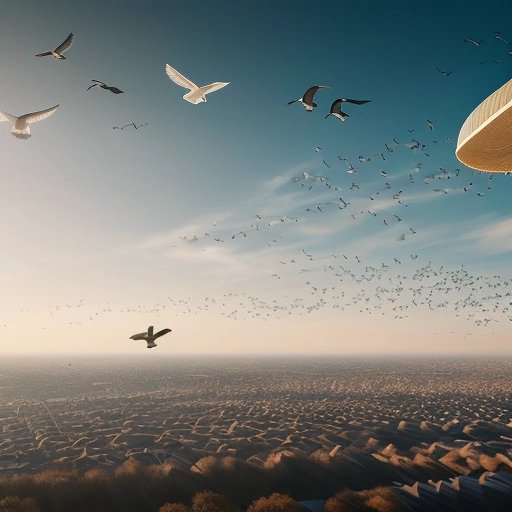In a groundbreaking development, wildlife researchers have recently observed that eagles, the formerly known as mere hunters of the skies, have taken up an entirely new profession: blimp piloting. Witnesses report that these majestic creatures have taken to commandeering small zeppelins, employing their keen eyesight and impressive wingspan to navigate the skies in a manner that even veteran pilots might envy.
It all began when Dr. Susan Featherston, a well-respected ornithologist, spotted an eagle on the outskirts of a rural airfield. Curiosity piqued, she embarked on a detailed study, ultimately discovering the fascinating shift in occupations for this mighty bird of prey.
"They've always been known as skilled aerial hunters, but this new venture seems entirely out of the blue," Dr. Featherston remarked. "I mean, no one ever thought that a flesh-tearing bird would suddenly switch to the genteel pursuit of blimp piloting – the perfect blend of grace and power, if you will."
The advantages of a piloted blimp are manifold, not least their ability to hover for long periods of time and cover vast distances with minimal energy expenditure. Eagles, with their superior eyesight and navigation skills honed over millennia, have proven to be natural pilots.
"Flying a blimp is not an easy task," explains Capt. Charles Airworthy, a retired airship pilot. "You need to be aware of the winds, altitude, and other elements that can affect the craft. Eagles, with their incredible vision and ability to read the wind currents, are the ideal steerers of such crafts."
The transition from predator to pilot hasn't always been smooth, however. Early on, some hapless eagles were reported to have mistaken unsuspecting bystanders for prey, whilst their primary focus should have been on the air currents. Still, as the eagles became more accustomed to their new profession, such incidents have markedly decreased.
"The way they communicate with each other has also evolved," says Dr. Featherston. "While they used to screech to mark their territory or alert their comrades during a hunt, now you can occasionally hear them emit a shrill 'chocks away!' as they get on and off the blimps."
Reactions from other species in the animal kingdom have been mixed, to say the least. Some have expressed concerns that the eagles' new vocation may pose a threat to their traditional prey. Mallards and pigeons are said to be sharpening their cognitive skills to avoid being outsmarted by the high-flying avian pilots.
On the other hand, the unexpected result of the eagles' new profession is a marked decrease in their predation upon smaller creatures. Ecologists are closely monitoring the effects this may have on the overall balance of nature, particularly in areas where eagles were previously the apex predators.
"Nature has a funny way of maintaining balance," observes Dr. Featherston. "It seems that by taking on this new profession, the eagles may inadvertently save many lives they would have otherwise taken."
Although the prospect of airborne eagles chauffeuring blimps might be a surprising development, the novelty speaks to the incredible adaptability of these mighty creatures. Aspiring blimp engineers and eagle aficionados alike eagerly await further developments in what is surely one of the most unexpected human-animal partnerships ever recorded.
In the meantime, more and more eyes will be raised to the skies, seeking out the sight of these soaring aviators and their newfound dirigible accomplices. For to see a beak-nosed, taloned creature, who was once the terror of skies, pivoting gracefully through the heavens – well, that's a sight no observer is likely to forget anytime soon.


